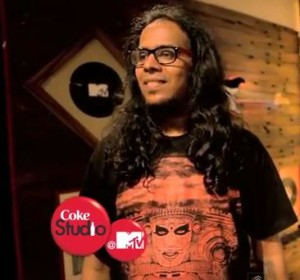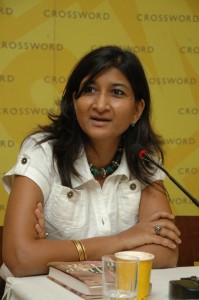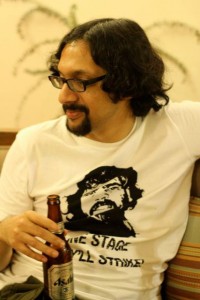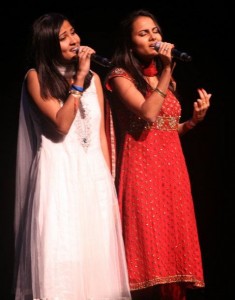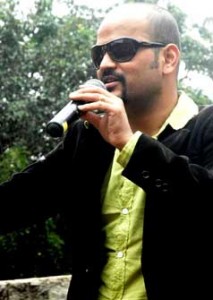Compiled by Anupama Krishnakumar
Music is an ocean. Many of us plunge into it for various reasons at different points in our lives. Music soothes, entertains, puts the spirit back into our souls, calms us down, lets us reflect and at other times, lets us get the sheer kick out of life. It means something for those who create it, something for those who receive it. Whatever be the genre, whoever you are – the creator or the listener, there’s one point that is undeniable – music is indispensable in human life; it adds meaning and a dash of colour to our existence. From nature to the most-technologically advanced gadgets, music seeps its way into our beings.
While it is indeed tough to get the complete picture of what music means to each and every one, given that music is such a nuanced experience, we at Spark, decided to talk to six very interesting people who are linked to the world of music in some way, to get an idea.
Spark is proud to feature Harish Sivaramakrishnan, Lead vocalist at Agam, a Bangalore-based music band that has been around since 2003, Namita Devidayal, Journalist and Author of the acclaimed books ‘The Music Room’ and ‘Aftertaste’, Krish Ashok, popular blogger known for the humour that permeates his writing, RJ Prithvi, the highly popular Radio Jockey at Radio One 94.3 FM Bangalore and Vidya & Vandana Iyer, the music sisters whose rendition of ‘Munbe Vaa’, ‘Ashai Mugam’ and ‘Nee Nenaindal’ with clarinetist and composer, Shankar Tucker went viral on YouTube.
These six people talk about what music means to them and provide a glimpse of how this beautiful art form has become a part of their lives. Diverse that their fields are, it is interesting to note how music can be learnt, savoured and shared in such different ways. We hope you enjoy the feature!
Harish Sivaramakrishnan, Lead Vocalist, Agam
[box type=”bio”] Harish Sivaramakrishnan is the lead vocalist of Agam, a contemporary carnatic rock act from Bangalore, India. Agam’s music combines the myriad hues of melodic scales and intricate rhythm structures offered by Carnatic music with the aesthetic principles and tonal elegance from western world. The band recently recorded for MTV Coke Studio Season 2 due to be aired soon. Harish shares his thoughts on music, his band, Agam, and their MTV Coke Studio experience.[/box]My earliest memories of music as a child are of my dad making me practise three hours every evening when most of my friends would be out playing cricket! I can also recall my grandfather playing the harmonium. He was so good that I would always wonder why I couldn’t play harmonium instead of practising singing! As far as my formal training goes, I underwent 16 years of training in Carnatic vocal. Most of my violin playing is derived from my vocal training and I am mostly self-taught when it comes to playing the violin. My technique would be found wanting at times, but I have evolved a way that suits the music that I play with Agam, my musical band.
Agam wasn’t entirely my idea. Ganesh, the drummer of Agam and I started jamming and writing original music. I think, we wrote Brahma’s Dance, one of our popular compositions, back in 2004. Later on, Swamy, keyboardist of Agam came in, and started writing some amazingly beautiful Tamil poetry that we went on to compose. It was Swamy who named the band Agam. Then, Vignesh and Praveen came in, and our sound took a dramatic turn, which came to define the sound of Agam as you hear today. The wish and passion to play original music is what keeps us going. Also, we are all friends even outside Agam. We share a wonderful camaraderie which reflects in the music that we make together. It is hard to keep count of the shows we have played, but I guess we would have done about 100 in the last two to two-and-a-half years.
A milestone in Agam’s journey is our recording for MTV Coke Studio. The experience was mind blowing. We spent almost 60 continuous hours making music and collaborated with couple of the most amazing musicians we have ever met (Butto on the flute and Arshad Khan on the Esraj). We worked on the arrangement of one of our tracks and the interpretation that we arrived at was awesome. We hope it strikes a chord with the audience as well, when it goes on air. Riad Saha, the man behind the show MTV Roots, heard us at the Storm Festival at Coorg and instantly liked our sound. It was through him that we met Chandrashekhar L, the head of music programming at MTV, who signed us up for Coke Studio.
What I strive to achieve through music is simple – stay happy. Music is more than a hobby or a passion for me. It is a part of me that is hard to define or express in words. If I am not playing music, I doubt if I’d be able to maintain my sanity. Playing music is a way of life for me and I will keep doing it till the end.
Namita Devidayal, Journalist & Author
[box type=”bio”] Namita Devidayal is a journalist with the Times of India and is also the author of the books, ‘The Music Room’ and ‘Aftertaste’. Her first book, ‘The Music Room’ is a memoir which reveals to the reader, the world of Indian classical music, and is a tribute to Namita’s music teacher, the legendary Dhondutai, who again is the disciple of the great singer Alladiya Khan. The book received rave reviews and also won the Crossword Popular Book Award in 2008. Namita talks about her music-learning years, her teacher, Dhondutai, and their student-teacher relationship, her book, ‘The Music Room’ and what music means to her. [/box]I started out as a reluctant student who was being forced to go for music lessons by her mother. I think it was a combination of two things that changed my outlook towards music – the first was the incredible love and patience of my teacher, Dhondutai; the second was the music itself which is so powerful and takes over, enters our being, without us even knowing it…I am in awe of Dhondutai’s tenacity and unconditional devotion to music. There were so many points where it would have been so easy for her to give up, take the easy way out, but she didn’t. She treated music like tapasya. The interesting thing is she was equally devoted to her singing as she was to her teaching. There is also an air of wisdom and insight about her that never ceases to amaze me. Finally, she has a great sense of humour! Like, the other day, we were learning Raga Malhar and she said to me, “If you keep singing like this, the rain will definitely not come!” I have shared so many memorable moments with Dhondutai. They are peppered all over my book, ‘The Music Room’. Like, going with her to the Mahalaxmi temple in Kolhapur and singing in the same spot where Alladiya Khan used to sing; or her teaching me the secret two note taan which I didn’t even know was such a fundamental feature in the Jaipur gharana and so on.
The idea of ‘The Music Room’ came to me very organically. I was taking a literary writing course at Columbia University in New York and the final assignment was to write the first chapter of a book. The one that flowed out was the story of a little girl and her music teacher. I later decided to develop this narrative and it came to me quite seamlessly, through a combination of memory and research. Clearly it was a story that was overflowing inside me. I also wanted to make the wonderful world of Indian classical music more accessible to people.
When I came back from Princeton, I actually spent a year almost living with Dhondutai as I wanted to do music professionally. However, I realised soon enough that I didn’t have the guts or stamina to do something where the outcome is so unpredictable, where you aren’t sure of your income. So I fell into my second love — writing. I loved journalism; it was like a paid adventure. And gradually, I moved on to books. Now both writing and music are equally beloved to me. Music has become a parallel track for me, as imperative as breathing. I sing almost every day. It has saved me, restored me, sustained me. I am so grateful to have it in my life. I am now working on another music book, a musical pilgrimage of sorts.
Krish Ashok, Blogger
[box type=”bio”] Krish Ashok is a popular blogger who blogs at ‘Doing Jalsa and Showing Jilpa’ where humour is one thing that cannot be missed! Among many things that he does, including starting and managing the highly popular project, ‘TamBrahm Rage’ on Tumblr, he also plays the violin. In a conversation that reveals his typical humour, Krish Ashok shares his views on music and how he fell into the music pool as a child. Laugh away![/box]Music has always played a huge role in my life. I love instruments and I collect them. I am eternally fascinated by the most abstract of art forms, namely instrumental music’s ability to so profoundly affect our minds. My earliest memories of music involve the random combination of Abba and BoneyM and Illayaraja. When my parents were young, they were bold enough to resist the social pressure of only listening to Carnatic music at home given the fact that many of our relatives are serious Carnatic musicians. My father’s exposure abroad meant that he bought home tapes that were either unavailable here or were too expensive. Once I made the mistake of expressing some semi-curiosity at my mom’s office picnic where the daughter of an oppressive violin teacher played the violin. Seeing that I appeared reasonably tone and rhythm sensitive and also that I was curious, my mom enrolled me right away with the oppressive violin teacher who banned English and film music from my repertoire. Thus began an almost decade long exercise in making me hate music of all kinds. I even wrote a blogpost about it sometime back! But what I have learnt of those years does help me come up with offbeat musical ideas. To say I compose would be a bit too much. A good friend, Harish, does all the arrangement and sequencing and I play three or four instruments. In short I am more a spark generator and performer. Harish does the formal “composing”. You can listen to the compositions at www.soundcloud.com/parodesynoise.
Vidya & Vandana Iyer, Singers
[box type=”bio”] Vidya and Vandana, the music sisters, shot to fame when three of their music videos, ‘Munbe Vaa’, ‘Ashai Mugam’ and ‘Nee Nenaindal’ that they recorded with clarinetist and composer, Shankar Tucker, went viral on YouTube. The sisters share their thoughts on music, the experience of working with Shankar Tucker and the success of their music videos.[/box]We started learning Carnatic music from a very young age and we have been formally trained for over 13 years. We learnt from D.K. Nagarajan, brother of late D.K. Pattamal. Coming from a whole family of music, it was just one of the many fine arts classes our mom enrolled us in. Eventually, we started focusing solely on music because we realised that we had a strong passion for it. When we practise together, we make sure we have the exact melodies for each line of a song. We work out any differences that we can hear and make sure our swaras are correct. We have been singing together for a while, so this has become a habit and not something we consciously work on.
When we recorded ‘Munbe Vaa’, ‘Ashai Mugam’ and ‘Nee Nenaindal’ with Shankar Tucker, to be honest, we really didn’t think it would garner so much attention or interest. We recorded the songs because we loved the melodies, and we were overwhelmed by all the support and encouragement we received. We think there are so many reasons our videos became popular: Shankar’s style of creating a fusion of western and Indian classical music, the videography, the melody in our songs, to name a few. Also, our songs are different in the sense that we are trying to bring a traditional element back to today’s music.
Shankar and we became friends after meeting at a youth service tour. We decided to perform together during one of the final stops of the tour and that’s when Shankar got the idea that we should make a YouTube video together. A year later, we actually got together and recorded it! Shankar is one of the most humble, hard-working and talented people we have ever met. Working with him is such a pleasure and an honour, because he’s so patient and truly a genius. It’s always amazing to observe the process of transformation of a song after we record it. Shankar always manages to surprise us with the beauty of the final product, which he weaves together eloquently.
As for our forthcoming projects, we do have a few things outlined. We just want to make a small difference in the world of music and touch people’s lives through music in a positive way. Facebook, alongside YouTube, has been a platform that has bridged us with our supporters out there.
RJ Prithvi, Radio Jockey
[box type=”bio”] If you live in Bangalore, you are sure to have heard Prithvi in the mornings on Radio One 94.3FM. Highly popular for the fun element and pranks in his shows, RJ Prithvi became a radio jockey by chance! He talks about how he landed up becoming an RJ, what he likes about his job and then some more about the music he enjoys. [/box]My becoming a Radio Jockey was definitely not a dream of many years. It was like a bolt from the blue. My profession as a Radio Jockey was preceded by a 12-year-stint as a lawn tennis professional with a state and a national ranking – No. 6 in the state and No. 42 in the country, and in fact, I came really close to being ranked in the world. I was part of the 1997 US Open (as a ball-boy though…giggles). My friends strongly believed that I must consider being an anchor while my mom helped me in my first audition at the All India Radio and there has been no looking back since then. RJ-ing is like a big release every morning. I like pulling pranks, flirting, singing my own version of the songs, bringing in fun, wit, humour and sarcasm into the show. I also like the fact that all of what I do on my show is immediately measured through the responses from my listeners. I like the fact that it gives me a lot of free time to pursue my other passions. Flying is my new found passion and I could not have done it if not for my free time. I fly my two-seater para-motored glider aircraft!
I like listening to music of all kinds as long as they don’t offend my ears! Metal DOES! I love Indian music including Bollywood, Ghazals and Indipop. What I listen to is usually subjective and mood dependent. I generally prefer melody in the songs that I listen to but at the same time, I also like songs like subah hone na de from Desi boyz, mitti mitti bol from Aisha. I also like fusion music – compositions that have a classical touch in commercial music or the influence of technology/electronics in devotional songs or Ghazals. Hariharan, Kailash kher, Mohit Chauhan, Tressy Chapman and Bob Marley are some of my favourite singers. I strongly believe that music can do so much. Listening to good music can be really enriching. It can touch your heart and soul. I feel that good music has to be objective.
Here’s one of my favourite playlists with the songs in no particular order: Saiyaan by Kailash Kher, Dil toh baccha hai ji from Ishqiya, Tum itna jo muskura rahe ho from Arth, Redemption song by Bob Marley and Let the music play by Shamur.
[facebook]share[/facebook] [retweet]tweet[/retweet]


